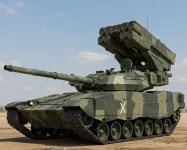- Views: 2K
- Replies: 14
In a move set to significantly advance India's military unmanned systems, the Indian Army and the Indian Air Force (IAF) are planning to arm their next generation of unmanned aerial vehicles (UAVs) with indigenous air-to-air missiles.
This initiative aims to transform the primary role of these drones from surveillance and reconnaissance to include formidable combat capabilities.
The plan involves integrating the Astra Mk1A, an Indian-developed Beyond Visual Range Air-to-Air Missile (BVRAAM), onto 87 Medium Altitude Long Endurance (MALE) UAVs that are slated for procurement.
According to official sources, the Defence Research and Development Organisation’s (DRDO) Aeronautical Development Establishment (ADE) is spearheading the effort to equip the Archer-NG UAV with two Astra Mk1A missiles.
The Archer-NG, an advanced version of the existing Tapas-BH-201 UAV, is a leading contender in this procurement program.
This development marks a crucial step in India’s air combat strategy by creating a versatile unmanned platform.
Each Archer-NG UAV would be equipped not only for intelligence, surveillance, and reconnaissance (ISR) missions but also to engage and neutralise aerial threats.
The Astra Mk1A missile, with an effective range of 110 kilometres, would enable the drone to counter slow-moving targets such as attack helicopters and other UAVs, and could even pose a threat to enemy fighter jets operating in contested airspace near the borders.
The operational doctrine for this new capability is particularly innovative.
The Archer-NG will feature an Active Electronically Scanned Array (AESA) radar, which serves a dual purpose: conducting detailed surveillance and providing fire control for launching the missiles.
A key feature of this system is its network-centric approach.
A missile launched from the UAV can receive mid-course guidance updates via a secure data link from manned fighter aircraft like the Su-30MKI or Tejas, or from Airborne Warning and Control System (AWACS) aircraft such as the DRDO Netra and the IAF's Phalcon systems.
This allows the drones to act as forward-deployed weapon platforms, controlled by personnel operating from safer distances deep within Indian airspace.
While the Archer-NG is a prime candidate for this upgrade, the integration of the Astra missile is part of a broader push to weaponise India's MALE UAV fleet.
The procurement process is expected to see competitive offers from various public and private sector companies, reflecting the nation's growing self-reliance in the defence sector.
The successful integration of the Astra Mk1A onto a UAV platform will represent a pioneering achievement for India's indigenous defence industry and provide a significant boost to the nation's unmanned combat capabilities.




